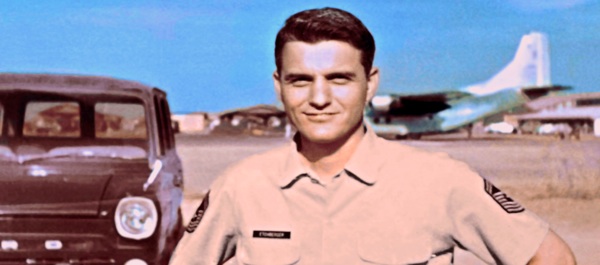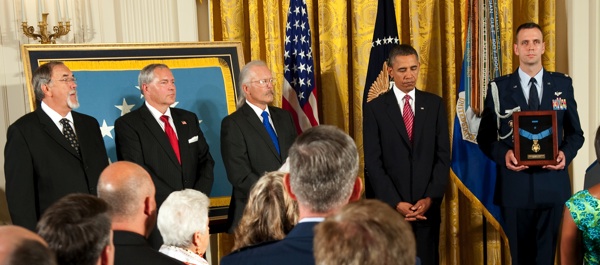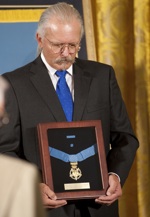
The Americans operating the radar at Lima Site 85 that night were killed almost immediately. Etchberger’s team managed to escape the initial slaughter and take cover on a ledge at about 3 a.m.
Ping. Ping. Ping. Whoosh. Whoosh. It was March 11, 1968, and the incessant sound of automatic weapons and rocket-propelled grenades shocked the airmen manning Lima Site 85, a top-secret radar station located in the mountains of Laos. They’d been attacked by the enemy before—when North Vietnamese aircraft had bombed them from above—but this was something entirely new and unexpected, because machine gun fire and grenades meant the enemy was on the ground and getting very near. By the end of the day, the U.S. Air Force personnel at Lima Site 85 had been in the fight of their lives, and one of them, Chief Master Sergeant Richard Etchberger, was dead after saving three of his fellow Americans.
So long kept under wraps, the story of Etchberger’s extraordinary heroism in combat demands retelling now because—more than 42 years after he was killed—the Air Force has finally awarded him the Medal of Honor.
In March 1968, Etchberger and 15 airmen—along with two CIA officers and a forward air controller—were living at Lima Site 85 in Laos. This was a highly secret radar facility needed by the USAF to direct strike missions in Laos and North Vietnam. Since targets located deep inside North Vietnam were impossible to bomb during darkness and bad weather, the Air Force had built the radar site atop Phou Pha Thi, a 5,600-foot mountain in northeastern Laos. Just 15 miles from the North Vietnamese border, the station was critical to the success of Operation Rolling Thunder, the ongoing bombing campaign begun by the Air Force in March 1965.
The radar site’s existence inside Laos was highly classified—and the operation was arguably illegal. An international agreement, signed by 14 countries in Geneva in 1962, prohibited the stationing of any military personnel in Laos. The intent of the agreement was to preserve Laotian neutrality and prevent the armed struggle between North and South Vietnam from spilling across the border. But the North Vietnamese, who had signed the agreement, were already violating it by transporting supplies through Laos along the supply route soon to become known as the Ho Chi Minh Trail.
Now, the United States, which had also signed the 1962 agreement, appeared to be doing the same—except that technically the Americans were actually complying with the agreement because there were no official “military personnel” at Lima Site 85. Etchberger and the other 15 airmen had “resigned” from the Air Force—in fact, they were honorably discharged—and were now “civilians” employed by Lockheed Aircraft Services. They would work at Lima Site 85 as civilians until their tour of duty was completed, at which time they would “return” to the Air Force and active duty. In CIA parlance, this process was called “sheep dipping,” after the chemical bath given to sheep to clean their wool prior to shearing.
Born in Hamburg, Pa., in March 1933, Richard Loy “Dick” Etchberger graduated from high school in 1951 and enlisted in the USAF a few months later. He liked being an airman and decided to make the Air Force a career. Etchberger excelled as a radio and radar maintainer, and his skills were rewarded: He was promoted to the highest enlisted rank, chief master sergeant, E-9, in April 1967.

Handpicked for the Lima Site 85 job (he was a ground radar superintendent), Etchberger traveled by helicopter to the secret radar station in Laos in November 1967. He was wearing civilian clothes and had no rank insignia—like everyone else on the mountaintop base. In the months that followed, Etchberger and his fellow Americans used their talents with radar to direct more than 500 bombing missions in Laos and North Vietnam. But the North Vietnamese also knew almost immediately that, if USAF bombers were able to strike despite heavy clouds and poor visibility, it was because the Americans were operating a radar site near the border—and they soon moved to take it out.
Four North Vietnamese Antonov An-2 biplanes attempted to destroy Lima Site 85 on January 12, 1968, by dropping 120mm mortar rounds on the Americans. A CIA-operated Air America UH-1B Huey, which had ferried ammunition to the site, chased two of the makeshift bombers. A crew chief firing an AK-47 from the helicopter managed to hit both planes—which subsequently crashed. This is believed to be the only time a helicopter shot down a fixed-wing airplane during the Vietnam War.
Their air attack having failed, the North Vietnamese returned with ground forces in March. After hundreds of soldiers of the North Vietnamese Army (NVA) 766th Regiment had encircled the site, blocking any ground escape routes, members of the 41st Sapper and 923rd Infantry Battalions climbed Phou Pha Thi on the night of March 10-11. The Americans knew that the enemy was coming, but also knew that darkness precluded their being rescued by helicopter until morning. Lieutenant Colonel Clarence F. “Bill” Blanton, the senior officer at Lima Site 85, intended to destroy the radar equipment before being evacuated, but the North Vietnamese had other plans. Having come up the lone path to the site, they began a diversionary attack. In the meantime, 33 sappers, who had spent two days climbing the cliffs, hit the Americans with machine guns and rocket-propelled grenades.
The Americans operating the radar that night were killed almost immediately. Etchberger’s team, which was resting nearby, managed to escape the initial slaughter and take cover on a ledge at about 3 a.m. However, the North Vietnamese soon discovered Etchberger and the six Americans who were still alive out of the original 19, and opened fire. Staff Sergeant Henry Gish was shot and wounded; he died after being wounded again a short time later. Technical Sergeant Donald Springsteadah also was hit and killed almost immediately. A third airman, Staff Sgt. John “J.D.” Daniel, was shot in both legs, but was alive. Captain Stanley J. Sliz was wounded and unconscious. As Daniel recalled in a recent interview, “Everybody was either dead or wounded except Dick Etchberger.” Though the Americans were in bad shape, those who still could fought back.
Despite withering artillery fire, Etchberger single handedly held off the attackers with an M-16 as he and the others kicked away the enemy grenades being thrown at them before they could explode. At one point, one fell out of reach for him to push it away with his arms, so Daniel pushed Gish’s dead body onto the grenade to absorb the blast.
Using Daniel’s radio, he and Etchberger directed American A-1E Skyraiders against the enemy. They repeatedly bombed the site and the North Vietnamese attackers. As dawn broke, a CIA-operated UH-1H Huey managed to reach the stranded Americans. Ignoring the hail of enemy bullets pinging all around him, Etchberger carried Daniel to a rescue sling, and then he helped Sliz, who was now awake and sufficiently alert, to get into the helicopter.
Suddenly a fifth American, Staff Sgt. Bill Husband, who had been “playing possum,” jumped up and ran toward the helicopter. Etchberger, who had refused to be evacuated until the others had been rescued, now saved Husband’s life by embracing him in a bearhug, and both men were lifted into the helicopter.
 As the CIA chopper began to fly away, the North Vietnamese let loose a hail of fire. At least one round struck Etchberger as he was being raised into the aircraft or just after he had been pulled inside. He bled to death before he could reach safety—and medical care—in Thailand. A total of 12 Americans had been killed, as well as 42 Thai and Laotian army Hmong personnel, but seven had survived—three of them as a direct result of Dick Etchberger’s gallantry.
As the CIA chopper began to fly away, the North Vietnamese let loose a hail of fire. At least one round struck Etchberger as he was being raised into the aircraft or just after he had been pulled inside. He bled to death before he could reach safety—and medical care—in Thailand. A total of 12 Americans had been killed, as well as 42 Thai and Laotian army Hmong personnel, but seven had survived—three of them as a direct result of Dick Etchberger’s gallantry.
Etchberger’s extraordinary heroism was recognized at the time as deserving of the Medal of Honor. His chain of command recommended him for the decoration, and Etchberger was restored to active duty so that he would be eligible to receive it posthumously. When the award recommendation reached the Pentagon, however, General Bruce K. Holloway, the Air Force vice chief of staff, advised against approving it. Giving Etchberger the nation’s highest military award would reveal the existence of the top-secret radar site in Laos, and highlight the fact that the Americans had been operating it in violation of international law.
As a result, President Lyndon B. Johnson declined to award the Medal of Honor, and the Air Force instead presented Etchberger’s widow with the Air Force Cross, the second-highest gallantry award, during a private ceremony in the Pentagon. She knew that her husband had been on a secret mission, as she had traveled with him to Washington, D.C., when he had undergone his “sheep dipping.” Still sworn to secrecy, she did not reveal the circumstances of his death even to her three children, who grew up believing that their father had died in a helicopter accident. Not until 1986, when the Air Force declassified the Lima Site 85 mission, did they learn the truth of what had happened to their father.
In 1999, historian Timothy Castle’s book One Day Too Long detailed the extraordinary events of March 10-11, 1968, and revealed that it was at Lima Site 85 that the Air Force had suffered its largest single ground combat loss of the Vietnam War. Soon thereafter, a group of retired Air Force veterans requested that Etchberger’s Air Force Cross be upgraded to the Medal of Honor for which he had originally been recommended.
While Secretary of the Air Force Michael B. Donley favored the upgrade, the problem was that special legislation was needed to waive the two-year time limit that ordinarily applies to Medal of Honor recommendations. Congressman Earl Pomeroy of North Dakota, who represents a district where Etchberger and his family were once stationed, and whose office had submitted the original Medal of Honor upgrade package to the Air Force in 2006, pushed hard for the legislation, and it passed the Congress in late 2008.
On September 21, 2010, more than 42 years after the attack on Lima Site 85 that cost Etchberger his life, his three sons received the Medal of Honor from President Barack Obama in a White House ceremony. His citation for the medal explains how Etchberger “repeatedly and deliberately risked his own life, exposing himself to heavy enemy fire in order to place three surviving comrades into rescue slings hanging from the hovering helicopter.” Then, about to reach safety himself, Etchberger “was fatally wounded by enemy ground fire.”
Dick Etchberger’s gallantry, self-sacrifice and profound concern for his fellow airmen has not been forgotten. As President Obama said in his remarks at the White House: “Even though it has been 42 years, it’s never too late to do the right thing. It’s never too late to pay tribute to our Vietnam veterans and their families.” John Daniel, who was the lone Lima Site 85 veteran to attend the White House ceremony, put it slightly differently: Etchberger, said Daniel, “was one hell of an NCO.”
Etchberger’s Medal of Honor is extraordinary on another count: It is the first Medal of Honor to an individual serving in the highest enlisted grade in any service. No other E-9 has been awarded the decoration while serving as a sergeant major (Army and Marine Corps), master chief petty officer (Navy), master gunnery sergeant (Marine Corps) or chief master sergeant (Air Force).
Author Fred Borch retired after 25 years of active duty as an Army lawyer and is the now the regimental historian and archivist for the Army Judge Advocate General’s Corps. His latest book, For Military Merit: Recipients of the Purple Heart, was published in 2010 by Naval Institute Press.




